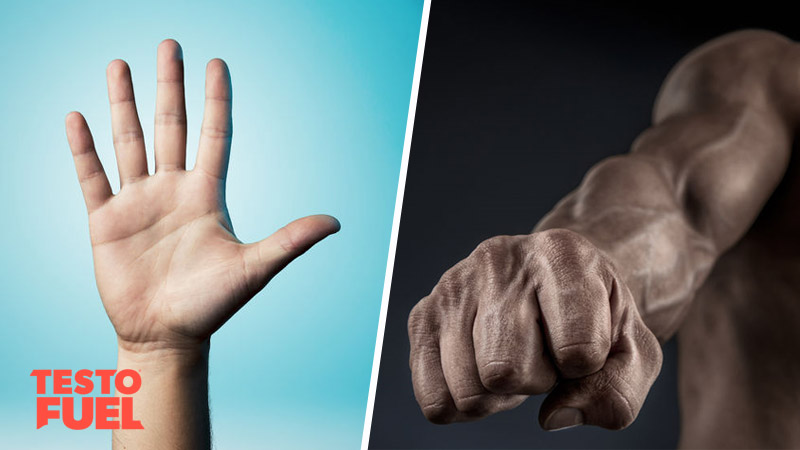TestoFuel Blog : Make Gains & Pack on the Muscle

There are so many giveaways when it comes to spotting someone with high testosterone.
They’re typically strong, dominant and assertive. They are confident and competitive. And you can tell by their physique that they look after themselves – lots of muscle and shredded body fat.
But other than looking them in the eyes or sneaking at peak at their physique how else can you tell?
In this article we’ll look at the current research on what your fingers say about your masculinity. Does your digit ratio really say how high your testosterone levels are?
Let’s find out…
Human hands are different to those of apes as we have longer thumbs relative to finger length. Our thumbs are also opposable, meaning we can grip, grab and hold much better than our hairier counterparts.
It is thought to be a characteristic that developed over millions of years of tool behaviour. The more we clubbed, bludgeoned and hurled things the more the need for functional hands was required.
The best at these activities would rise in the male dominance hierarchy and therefore be presented with more breeding opportunities [1].
And nothing says masculinity more than having to club a rival caveman into submission in order to win the affections of the best loin-clothed female.
Let’s start by taking a look at your hands. Turn your palm away from you and close your fingers in together.
As you look down at the top of your hand you’ll see you thumb. This is what’s referred to as the pollex or first digit. This unique appendage allows you to grip like no other primate.
From there you’ll have an additional four digits.
The first two fingers are referred to as the first/index finger (second digit) and middle finger (third digit). These two are particularly important in gripping and throwing.
You’ve then got your ring finger (fourth digit) and little finger or pinky (fifth digit). These function to assist with grip and move the back of the hand inwards to close the hand when you flex them.
Men don’t all have the same length fingers. You might have noticed this before, or you might not have.
But nevertheless, your fingers can tell you a great deal about your exposure to testosterone in the womb. They can also tell you a bit about your athleticism and personality characteristics too.
The digit ratio is typically the ratio between the length of each of your fingers, as measured from the tip of your finger to the base where it meets your hand.
There’s two fingers that are of importance here – your second and fourth digits, or 2D and 4D.
Research shows that men tend to have shorter second digits in comparison to fourth. Whereas for women it’s not as prevalent. They tend to have second and fourth digits of either equal length, or have longer second fingers.
These gender differences are referred to as sexually dimorphic.
In the late 1990’s, it was suggested that these differences could be down to how much testosterone you were exposed to in the womb [2].
This was backed up by other studies too.
The ratio between your second and fourth digits tell you quite a lot. And it’s not some backstreet palm reading illusion either.
You work your 2D:4D ratio out by simply measuring the length of your index finger and dividing it by the length of your ring finger.
According to research from Biological Psychology [3], the average 2D:4D for men is 0.947 and for women it is 0.965. That means that most men have longer ring fingers than index.
The second to fourth digit ratio is a sexually dimorphic trait with lower finger ratios considered more masculine [4].
Those with a low 2D:4D (indicating a long ring finger relative to the index finger) have been found to have:
And men with lower androgen levels? They tend to have more equal length digits in line with females.
Your 2D:4D tells you how much testosterone you were exposed to as a developing fetus in the womb.
It gives an indication of how masculinized your body is.
You’ll find that low 2D:4D men are confident and assertive.
Those with lower digit ratios show more aggressive behavior and more dominating personalities – both hallmarks of high testosterone levels.
One study [5], showed that in a group of 171 healthy men, low 2D:4D was associated with competitiveness and aggression, whereas in women there was no association found.
A 2016 study found that low digit ratio men are faster, more athletic and have better spatial awareness [4]. They are also risk takers.
To use the evolutionary terminology again, this makes them perfect hunter-gatherers. The most manly of jobs.
It’s not all good though. Low digit ratios may also linked to higher incidences of alcoholism and video game addictions too [6].
High ratio men on the other hand can be more superstitious and have a nice, agreeable charm to their personality. They are less threatening to females which is probably why they’re more likely to have female friends.
They are also more likely to suffer from eating disorders, and may even have more feminine handwriting.
Research also shows that gay men might have a higher incidence of high 2D:4D, whereas gay women could have lower 2D:4D [7].
Currently there’s a bit of discrepancy in the research and no agreement has been made. Why? Well, there are some studies saying that there’s a link and others saying there isn’t.